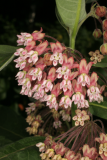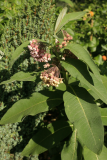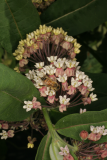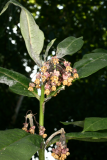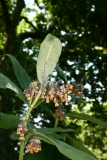Additional notes (click to expand)
Commemorative
Asclepias syriaca is named for Asclepius, the Greek god of medicine (Aesculapius in the Roman pantheon), the son of Apollo. He probably existed around 600 BC, but became a Roman god in c. 295 BC. Apollo was the god who kept disease away and Telesphorus, the short person with the woolly hat who accompanies Asclepius in the Royal College of Physicians’ statue, was the god of convalescence. Asclepius was regarded as a ‘hands-on’ physician who intervened with drugs and surgery when a person was ill. His staff, with a single snake twined round it, is the symbol of medicine, and is used as the logo of the British Medical Association and the American Medical Association. The caduceus, two snakes twined round a winged staff, was given to Hermes, the messenger of the gods, by Apollo and is not a medical symbol, although it has been so used in error (Graf, 2009). The mythology of Asclepius is convoluted, and there are several versions. Ovid’s (AD 8) version was that his mother was Coronis, daughter of Phlegyas, king of the Lapiths. Apollo
killed her when he heard she was a lover to someone else. The baby Asclepius, delivered by caesarean section from the dead Coronis as she lay on her burning funeral pyre by the repentant Apollo, was brought up by the centaur Chiron (who also brought up Achilles qv). Asclepius became so skilled that he was able to revive the dead, and Zeus killed him with a bolt of lightning. One version states that this was at the request of Pluto, king of the Underworld, who had become worried that Asclepius might keep everyone alive so there would be no more souls to enter Hades.
Oakeley, Dr. Henry. (2012). Doctors in the Medicinal Garden. Plants named after physicians. Royal College of Physicians. p. 26 et seq
link
Nomenclature
Asclepias tuberosa is named for Asclepius, the Greek god of medicine. See Commemorative
Toxicity
Many, if not all, members of this genus contain toxic resinoids, alkaloids and cardiac glycosides. [Diggs, Jnr. G.M.; Lipscomb. B. L. & O'Kennon. R. J Illustrated Flora of North Central Texas Botanical Research Institute, Texas. 1999]
https://pfaf.org https://pfaf.org/user/plant.aspx?LatinName=Asclepias+incarnata
Geographical distribution
- Northern America, Eastern Canada
- Northern America, North-Central U.S.A.
- Northern America, Northeastern U.S.A.
- Northern America, Northwestern U.S.A.
- Northern America, South-Central U.S.A.
- Northern America, Southeastern U.S.A.
- Northern America, Southwestern U.S.A.
- Northern America, Western Canada
Asclepias syriaca L.
Family: APOCYNACEAEGenus: Asclepias
Species: syriaca L.
Common names: Common Milkweed, Silkweed
Distribution summary: Canada, United States
Habit: Perennial
Hardiness: H5 - Hardy; cold winter
Habitat: Roadsides, wasteland & cultivated land
Garden status: Currently grown
Garden location: Plants of the World (B)
Flowering months: July, August
Reason for growing: Commemorative, toxic

